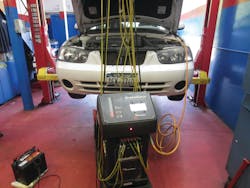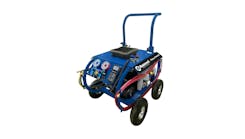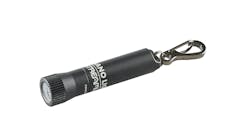Q: How can we find out if the front or rear rotors are warped?
A: There are two methods and both are imperfect, because they don't make a scan tool for brake rotors!
The first method is to test drive the vehicle and feel the shaking when braking. If the seat or pedal shakes first, you likely have warped rear rotors. Now, when the steering wheel shakes, the front brakes probably need the work.
This method is imperfect for several reasons. First, you might feel shaking in both or the shaking might be ambiguous. You see, what if the vehicle shakes in the seat at 40 MPH, but in the steering wheel at 55 MPH? It would be hard to be confident in your diagnosis merely by feeling. Second, there will be times when customers complain "when I drive 85 MPH on the freeway, it shakes like crazy." Granted, if Sammy Hagar can't drive 55 MPH, he should not be doing 85 MPH, but the customer brought the car to your shop to fix the problem. What do you do?
This is when a dial indicator becomes handy. After you attach the dial indicator and spin the rotor with a screwdriver or pry bar, the needle will tell you how warped the rotor is by thousandths of an inch. Most manufacturers (excluding the European ones) will publish specifications on how much "run-out" is acceptable, usually within 0.002" to 0.005". You can easily look up this information in shop information systems.
Sometimes, you cannot easily measure run-out on the backside of the rotor or even after measuring it you cannot find anything. In this situation it would be best to try to see how uneven the rotor is going latitudinally instead of around, or simply compare the rotors. If the left rear rotor is 0.004" while the front are both "0.0015, rear rotors should do the trick.
Q: What's the best way to prevent premature wear?
A: Procedure is very important when it comes to brake work. Take a look at if the shims are lubricated (uneven brake wear could be from a lack of lubrication), and if not, see if one side is wearing differently than the other.
Granted, if workmanship is fine you can have a brake caliper acting up and you can diagnose this with a brake caliper pressure gauge. To use it, put the block that the gauge is attached to in place of the brake pad and step down on the brakes. Simply compare the questionable caliper to the good one and see if the pressures are different. If there is a difference greater than 10 percent, you can sell calipers along with pads and rotors.
Q: I have too many brake comebacks, what should I do?
A: Most of the time, unless workmanship is grossly deficient, comebacks are the result of parts defects. Brakes shake even with new rotors and squeak with new brake pads. Sound familiar? The parts guy might sing a different tune, but let's get real; there's a reason aftermarket rotors and brake pads are a lot cheaper and made in countries that are tough to pronounce — their quality is much lower. So, if you put low quality parts on cars, don't act flabbergasted that the brakes come back to your shop to say hello.
There are a few ways you can correct this. You can try to compensate for the parts with quality workmanship (i.e., sanding down the hubs, cleaning and lubricating the shims, etc.), but you should be doing these things anyway. You can also employ the use of brake lathes. New rotors come warped out of the box, because quite simply, the machining practices in China are different than that in the countries where they make OE rotors.
Last but not least, try to upsell the customer on quality brake pads. For an extra $40, you can tell them, your brakes won't squeak. OE brake pads from Toyota, Honda, Nissan and Ford all tend to sell to the customer for $60 to $80 a pair. A set of Akebonos might sell for about $100. In all probability, you are using a set of pads that you buy for $20 to $30 and sell for $50 to $60. Customers always claim they want it cheap, but give them the $40 option of upgrading their pads. Most will dig deep in their wallet and find the cash.
Q: What can I do to stop a squishy brake pedal?
A: Have you ever noticed that the labor time for bleeding brakes is 0.6 to as high as 1.1? It's a money maker, sure, but the guys coming up with the labor time are not assuming that all you have is a guy stepping on the brake pedal and another guy with a 10mm wrench loosening the bleeder. However, when you do calipers (or bleed a clutch master cylinder), stepping on it just does not cut it sometimes.
This is when you need a powered brake flush machine. It cuts down on manpower to do a bleed/flush because it adds pressure to the master cylinder (through the use of an adapter), so that way you don't have to step on anything. Again, this is not a sales pitch for a machine. It's just that sometimes after a caliper job or brake lines, no amount of stepping on it will bleed the car right. These machines exist for a purpose, and aside from acting as a labor-saving device, this is one of them.
Also, watch out on certain vehicles where you will need to activate the ABS pump with a scan tool to get the job done.
Q: What's with all the hype I hear about brake lathes?
A: Due to the increasing amount of brake pulsation comebacks, most OEs require that their dealers use an on-the-car brake lathe. The benefit of an on-the-car brake lathe is that it can compensate for run-out issues that may be caused by a hub. For example, if you replace a hub assembly, the run-out on the rotor might change because the angle of the rotor may be altered by hub placement. Now, there is nothing wrong with a bench lathe, because it requires less finagling (moving it around the shop, adjusting it for different hubs, etcetera). However, you just can't compensate for hub run-out.
If you don't have a brake lathe, you're probably used to a degree of pulsation comebacks and have learned to live with them. However, if you work in one of the shops that still "cuts" brakes, you know why they come in real handy. Rotors can be really messed up. Factory machining is often substandard, and the only way to have a true comeback-free brake job with the vast majority of aftermarket rotors is to cut every rotor.
The problem is, in the real world, cutting rotors on the car can be a 40-minute process for many technicians. A lot of guys can do pads and rotors that quickly. If you work on a lot of vans (whose rotors are very expensive) or have customers willing to pay for a superior brake job, an on-the-car brake lathe is the way to go.
Have questions? Need answers? Email [email protected] to have your questions answered in this column.


